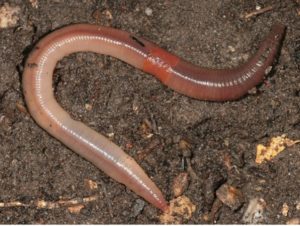By Bernie Williams, invasive plants and earthworms specialist, Madison, Bernadette.Williams@wisconsin.gov, 608-444-6948
As the weather warms up and more of us are out in our gardens digging around, it seems like a good time to learn a few things about those fascinating and beautiful worms you keep encountering.

Nightcrawlers have reddish-pink bodies and can be 6-8 inches long when mature.
Earthworms, specifically nightcrawlers, or Lumbricus terrestris, are amazing animals. There are literally hundreds of different things I could tell you about them, but I’ll try to narrow it down to just the top ten!
- They are everywhere. There are over 9000 documented species worldwide! There is no place too cold, too hot, too dry or too wet that they can’t be found because in a nutshell, they are the pioneers of colonization! Wherever people go, worms go too, and just like people they are very good at changing the environment to suit their survival.
- Great for soil and gardeners. Farmers and gardeners love worms because they feed the soil. Often referred to as “nature’s recyclers,” few people realize that worms actually make a nitrogen compound in the clear slime they produce. Nitrogen feeds soil, so worms provide invaluable services for people who farm or garden.
- Rings! Worms are annelids, which in Latin means “rings.” Their bodies are composed of segmented rings and the cool thing about that is each one of their “rings” has a specific role that it plays in worm survival and reproduction. It might not seem that way at first glance, but worms are a pretty advanced life form!
- Lots of heart. Worms have five hearts. Technically, they have five ventricle valves, not hearts per se, though in an animal as small as a worm, I’m going to call them hearts.
- Worms are not from here. They came along to the Americas with the European settlers. In fact, you can trace their entrance point to the first explorers who dumped ballast water on the eastern seaboard of North America. Remember, they are “pioneers of colonization.”
- They live underground where it’s cool, dark and most importantly, safe.
- Tongues! Worms have a proboscis (tongue) just like a butterfly and they too have favorite foods just like us. They prefer materials high in sugar, carbohydrates and potassium.
- Getting back to the butterfly connection, worms reproduce in a unique way by shedding cocoons. Every worm has both male and female reproductive organs, and that nitrogen slime I mentioned earlier plays an important role in forming the cocoons that slide off their heads.
- No divide and conquer. Don’t cut worms in TWO! That just won’t do. I don’t know how that rumor ever got started, but it does not work on worms.
- Lastly Charles Darwin once said: “I doubt that there are any other animals which have played so important a part in the history of the world.” I tend to agree. Earthworms can survive almost anywhere, and their ability to adapt to change far outweighs most animals’ except of course Homo sapiens. Is it too far to say that to be human is to be a worm?
Wait, what about different types of worms? Stay tuned, next month we’ll jump into jumping worms.
(Visited 5,557 times, 2 visits today)
